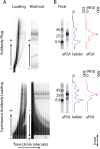Microfluidic Western blotting of low-molecular-mass proteins
- PMID: 25268977
- PMCID: PMC4222625
- DOI: 10.1021/ac5024588
Microfluidic Western blotting of low-molecular-mass proteins
Abstract
We describe a microfluidic Western blot assay (μWestern) using a Tris tricine discontinuous buffer system suitable for analyses of a wide molecular mass range (6.5-116 kDa). The Tris tricine μWestern is completed in an enclosed, straight glass microfluidic channel housing a photopatterned polyacrylamide gel that incorporates a photoactive benzophenone methacrylamide monomer. Upon brief ultraviolet (UV) light exposure, the hydrogel toggles from molecular sieving for size-based separation to a covalent immobilization scaffold for in situ antibody probing. Electrophoresis controls all assay stages, affording purely electronic operation with no pumps or valves needed for fluid control. Electrophoretic introduction of antibody into and along the molecular sieving gel requires that the probe must traverse through (i) a discontinuous gel interface central to the transient isotachophoresis used to achieve high-performance separations and (ii) the full axial length of the separation gel. In-channel antibody probing of small molecular mass species is especially challenging, since the gel must effectively sieve small proteins while permitting effective probing with large-molecular-mass antibodies. To create a well-controlled gel interface, we introduce a fabrication method that relies on a hydrostatic pressure mismatch between the buffer and polymer precursor solution to eliminate the interfacial pore-size control issues that arise when a polymerizing polymer abuts a nonpolymerizing polymer solution. Combined with a new swept antibody probe plug delivery scheme, the Tris tricine μWestern blot enables 40% higher separation resolution as compared to a Tris glycine system, destacking of proteins down to 6.5 kDa, and a 100-fold better signal-to-noise ratio (SNR) for small pore gels, expanding the range of applicable biological targets.
Figures




Similar articles
-
Microfluidic Western blotting.Proc Natl Acad Sci U S A. 2012 Dec 26;109(52):21450-5. doi: 10.1073/pnas.1207754110. Epub 2012 Dec 5. Proc Natl Acad Sci U S A. 2012. PMID: 23223527 Free PMC article.
-
Fabrication of an Open Microfluidic Device for Immunoblotting.Anal Chem. 2017 Sep 19;89(18):9643-9648. doi: 10.1021/acs.analchem.7b02406. Epub 2017 Sep 7. Anal Chem. 2017. PMID: 28825964 Free PMC article.
-
Microfluidic integration of Western blotting is enabled by electrotransfer-assisted sodium dodecyl sulfate dilution.Analyst. 2013 Jan 7;138(1):158-63. doi: 10.1039/c2an36033k. Epub 2012 Oct 8. Analyst. 2013. PMID: 23042290
-
[Laboratory on a microfluidic chip].Se Pu. 2005 Sep;23(5):456-63. Se Pu. 2005. PMID: 16350786 Review. Chinese.
-
A brief review of other notable protein blotting methods.Methods Mol Biol. 2009;536:367-84. doi: 10.1007/978-1-59745-542-8_38. Methods Mol Biol. 2009. PMID: 19378075 Review.
Cited by
-
Recent Advances in Microscale Western Blotting.Anal Methods. 2016 Oct 21;8(39):7002-7013. doi: 10.1039/C6AY01947A. Epub 2016 Sep 15. Anal Methods. 2016. PMID: 28392839 Free PMC article.
-
Capillary electrophoresis Western blot using inkjet transfer to membrane.J Chromatogr A. 2022 Aug 30;1679:463389. doi: 10.1016/j.chroma.2022.463389. Epub 2022 Jul 30. J Chromatogr A. 2022. PMID: 35933772 Free PMC article.
-
The Intriguing Landscape of Single-Cell Protein Analysis.Adv Sci (Weinh). 2022 Apr;9(12):e2105932. doi: 10.1002/advs.202105932. Epub 2022 Feb 24. Adv Sci (Weinh). 2022. PMID: 35199955 Free PMC article. Review.
-
Integration of hydrogels into microfluidic devices with porous membranes as scaffolds enables their drying and reconstitution.Biomicrofluidics. 2022 Oct 27;16(5):054108. doi: 10.1063/5.0100589. eCollection 2022 Sep. Biomicrofluidics. 2022. PMID: 36313189 Free PMC article.
-
Controlling the separation of native proteins with temperature in thermal gel transient isotachophoresis.Anal Bioanal Chem. 2023 Jul;415(18):4163-4172. doi: 10.1007/s00216-022-04331-w. Epub 2022 Sep 23. Anal Bioanal Chem. 2023. PMID: 36151350 Free PMC article.
References
-
- Soundy P.; Harvey B. In Medical Biomethods Handbook; Walker J. M., Rapley R., Eds.; Humana Press: Totowa, NJ, 2005; pp 43–62.
-
- Allain J.-P.; Paul D.; Laurian Y.; Senn D. Members of the AIDS–Haemophilia French Study Group. Lancet 1986, 328, 1233–1236. - PubMed
-
- Shayesteh L.; Lu Y.; Kuo W.-L.; Baldocchi R.; Godfrey T.; Collins C.; Pinkel D.; Powell B.; Mills G. B.; Gray J. W. Nat. Genet. 1999, 21, 99–102. - PubMed
-
- Ghaemmaghami S.; Huh W.-K.; Bower K.; Howson R. W.; Belle A.; Dephoure N.; O’Shea E. K.; Weissman J. S. Nature 2003, 425, 737–741. - PubMed
-
- Dalmau J.; Furneaux H. M.; Gralla R. J.; Kris M. G.; Posner J. B. Ann. Neurol. 1990, 27, 544–552. - PubMed
Publication types
MeSH terms
Substances
Grants and funding
LinkOut - more resources
Full Text Sources
Other Literature Sources

